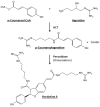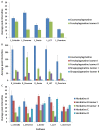Hordatines and Associated Precursors Dominate Metabolite Profiles of Barley (Hordeum vulgare L.) Seedlings: A Metabolomics Study of Five Cultivars
- PMID: 35448497
- PMCID: PMC9030721
- DOI: 10.3390/metabo12040310
Hordatines and Associated Precursors Dominate Metabolite Profiles of Barley (Hordeum vulgare L.) Seedlings: A Metabolomics Study of Five Cultivars
Abstract
In the process of enhancing crop potential, metabolomics offers a unique opportunity to biochemically describe plant metabolism and to elucidate metabolite profiles that govern specific phenotypic characteristics. In this study we report an untargeted metabolomic profiling of shoots and roots of barley seedlings performed to reveal the chemical makeup therein at an early growth stage. The study was conducted on five cultivars of barley: 'Overture', 'Cristalia', 'Deveron', 'LE7' and 'Genie'. Seedlings were grown for 16 days post germination under identical controlled conditions, and methanolic extracts were analysed on an ultra-high performance liquid chromatography coupled to high-resolution mass spectrometry (UHPLC-HRMS) system. In addition, an unsupervised pattern identification technique, principal component analysis (PCA), was performed to process the generated multidimensional data. Following annotation of specific metabolites, several classes were revealed, among which phenolic acids represented the largest group in extracts from both shoot and root tissues. Interestingly, hordatines, barley-specific metabolites, were not found in the root tissue. In addition, metabolomic profiling revealed metabolites potentially associated with the plants' natural protection system against potential pathogens. The study sheds light on the chemical composition of barley at a young developmental stage and the information gathered could be useful in plant research and biomarker-based breeding programs.
Keywords: Hordeum vulgare; anti-microbial metabolites; barley; liquid chromatography; mass spectrometry; metabolomics; multivariate data analysis; secondary metabolites.
Conflict of interest statement
The authors declare no conflict of interest.
Figures









Similar articles
-
Metabolomic Reconfiguration in Primed Barley (Hordeum vulgare) Plants in Response to Pyrenophora teres f. teres Infection.Metabolites. 2023 Sep 7;13(9):997. doi: 10.3390/metabo13090997. Metabolites. 2023. PMID: 37755277 Free PMC article.
-
Metabolic Reprogramming of Barley in Response to Foliar Application of Dichlorinated Functional Analogues of Salicylic Acid as Priming Agents and Inducers of Plant Defence.Metabolites. 2023 May 17;13(5):666. doi: 10.3390/metabo13050666. Metabolites. 2023. PMID: 37233707 Free PMC article.
-
Chemical Biology Meets Metabolomics: The Response of Barley Seedlings to 3,5-Dichloroanthranilic Acid, a Resistance Inducer.Molecules. 2025 Jan 25;30(3):545. doi: 10.3390/molecules30030545. Molecules. 2025. PMID: 39942649 Free PMC article.
-
A Metabolomics Approach and Chemometric Tools for Differentiation of Barley Cultivars and Biomarker Discovery.Metabolites. 2021 Aug 26;11(9):578. doi: 10.3390/metabo11090578. Metabolites. 2021. PMID: 34564394 Free PMC article.
-
Germination under the dark as an efficient method to enrich barley hordatine aglycones and to prepare a hordatine-rich fraction.Food Chem. 2025 Apr 30;472:142963. doi: 10.1016/j.foodchem.2025.142963. Epub 2025 Jan 18. Food Chem. 2025. PMID: 39842199
Cited by
-
Metabolomic Reconfiguration in Primed Barley (Hordeum vulgare) Plants in Response to Pyrenophora teres f. teres Infection.Metabolites. 2023 Sep 7;13(9):997. doi: 10.3390/metabo13090997. Metabolites. 2023. PMID: 37755277 Free PMC article.
-
Potential Hepatoprotective Effects of Chamaecyparis lawsoniana against Methotrexate-Induced Liver Injury: Integrated Phytochemical Profiling, Target Network Analysis, and Experimental Validation.Antioxidants (Basel). 2023 Dec 14;12(12):2118. doi: 10.3390/antiox12122118. Antioxidants (Basel). 2023. PMID: 38136237 Free PMC article.
-
In vivo tracking of grape marc biomarkers, bioconversion, metabolic tracers, and microbiota modulation in swine fed a polyphenol-rich extract diet.PLoS One. 2025 Jun 10;20(6):e0325079. doi: 10.1371/journal.pone.0325079. eCollection 2025. PLoS One. 2025. PMID: 40493643 Free PMC article.
-
Metabolic Reprogramming of Barley in Response to Foliar Application of Dichlorinated Functional Analogues of Salicylic Acid as Priming Agents and Inducers of Plant Defence.Metabolites. 2023 May 17;13(5):666. doi: 10.3390/metabo13050666. Metabolites. 2023. PMID: 37233707 Free PMC article.
-
Chemical Biology Meets Metabolomics: The Response of Barley Seedlings to 3,5-Dichloroanthranilic Acid, a Resistance Inducer.Molecules. 2025 Jan 25;30(3):545. doi: 10.3390/molecules30030545. Molecules. 2025. PMID: 39942649 Free PMC article.
References
-
- Holopainen-Mantila U. Composition and structure of barley (Hordeum vulgare L.) grain in relation to end uses. Academic dissertation, University of Helsinki, Finland. VTT Sci. 2015:1–108.
-
- Angessa T.T., Li C. Exploration and utilization of genetic diversity exotic germplasm for barley improvement. In: Zhang G., Li C., editors. Exploration, Identification and Utilization of Barley Germplasm. 1st ed. Elsevier Inc.; Amsterdam, The Netherlands: Academic Press; Cambridge, MA, USA: 2016. pp. 223–240. Chapter 9.
-
- Dai F., Zhang G. Domestication and improvement of cultivated barley. In: Zhang G., Li C., editors. Exploration, Identification and Utilization of Barley Germplasm. 1st ed. Academic Press; Cambridge, MA, USA: 2016. pp. 1–26. Chapter 1.
-
- Grando S., Macpherson H.S., editors. Food Barley: Importance, Uses and Local Knowledge. ICARDA; Aleppo, Syria: 2005. pp. 1–156.
LinkOut - more resources
Full Text Sources

